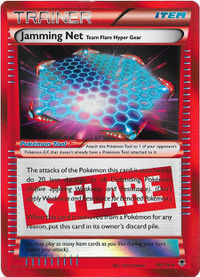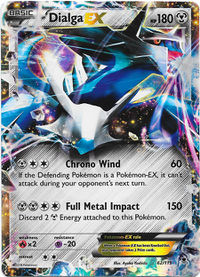Changes to Definition of the Term “Defending Pokémon”
|
|
Rules Team and Team Compendium member, PokePop, recently posted a helpful guide for PokéGym explaining the new definition of the term 'Defending Pokémon' on Pokémon cards, how it has changed, and how this new definition affects gameplay. Introduced with the XY expansion, this new official interpretation is only for cards released during the XY Series of Generation VI. As cards use the meaning of game terms from the Series that they were printed, the definition does not affect cards from prior to XY. His post from the linked article is posted below for convenience's sake. As this will have significant changes to how certain cards interact with others, any and all questions should be posted on the PokéGym thread for this post or the Ask the Rules Team forum over on PokéGym. We at Bulbagarden are simply reposting this in order to alert as many people as possible to the change.
Changes to Definition of the Term “Defending Pokémon”
The Defending Pokémon isn’t what it used to be. No, really. The meaning of the term “Defending Pokémon” has changed and virtually no one noticed!
Up until the release of XY, the definition of “Defending Pokémon”, as found in the TCG Rule Book Glossary, has been:
- Your opponent’s Active Pokémon during your attack.
While players have gotten used to that terminology, it actually was pretty redundant and confusing in some situations. If the Defending Pokémon is always your opponent’s Active Pokémon, then why not just say that? Also, sometimes a card would refer to the Defending Pokémon during the other player’s turn, when it wasn’t the Defending Pokémon, leading to confusion (see Stormfront Gengar’s Fainting Spell Poké-Power).
This card had to get an errata since the text, as written, would literally mean Gengar itself. In the original Japanese, there were two terms that were used in card text, and both were translating to “Defending Pokémon” in the past. With the release of XY, Pokemon is now translating each term into it's own English equivalent.
From the current Rule Book for XY:
- XY1 Rulebook, Glossary Pg 27
- DEFENDING POKÉMON: The Pokémon that receives an attack.
So now, the "Defending Pokémon" is any Pokémon hit by an attack (including Pokemon on the Bench).
And the “Opponent’s Active Pokémon” is ..well… the opponent’s active Pokémon.
While this is understandably causing some initial confusion among the players, in the long run, this should help with clarity in the Pokemon Trading Card Game, since each term can be used to give specific meaning to different cards' texts. But bear in mind that there is going to be a transition period where cards printed from prior to XY will have the old meaning for “Defending Pokémon”. As always, cards use the meaning of game terms from the era that they were printed. The definition is NOT retroactive to cards from prior to XY.
How is this used in practice?
Generally, Attacks and Abilities will refer to the opponent's Active Pokemon when an effect will resolve immediately. A Special Condition is being placed, an energy card is being discarded, etc. Whatever is happening, is happening now. The Active Pokemon is going to be the Active Pokemon for the resolution of this effect.
Generally, Attacks and Abilities will refer to the Defending Pokemon when an effect will remain for a duration or resolve in the future. If Active Pokemon was used, the opponent might not still have the same Active Pokemon when the effect is to be resolved. And, it also allows for the indication of multiple targets/affected Pokemon.
Note: As usual, all effects are cleared/removed when the Pokemon that they are on is moved to the Bench or evolves (unless otherwise specified).
Let's take a look at some examples and how this impacts the cards meanings using actual example.
|
|
Jamming Net (pictured above): Here, the card text says that the damage reduction applies to damage done to "all" Defending Pokemon. So, if an attack damages multiple Pokemon, including those on the bench.
- Dialga EX
Dialga EX's Chrono Wind mentions an effect to be placed on the Defending Pokemon, that if it is a Pokemon EX, it can't attack next turn. This refers to the current Active Pokemon, at the time of the attack. This is the Pokemon that took damage from the attack. This added effect is placed on it for the duration of the next turn. If a new Pokemon becomes Active, it is not affected by this effect.
- Gliscor
Gliscor, from Phantom Forces, is an excellent card for reviewing the differences between the terms "Defending Pokemon" and "opponent's Active Pokemon", because each of it's two attacks reference one of those terms.
The first attack, Submission Hold, states that the opponent can't attach energy cards to the Defending Pokemon on their next turn.
this references the Pokemon that was damaged and talks about an effect that will be in place for a period of time. One turn, in this case. It only means that Pokemon that was damaged by the attack and no other.
The second attack, Poison Jab, states that the opponent's Active Pokemon is now Poisoned. This is an immediate effect that is resolved during the attack and so does not have to be kept track of in the future. Of course, the Special Condition will remain, but that has rules of it's own to follow and is no longer an attack effect once it has been placed.
There are still some areas of clarification to be made and we'll get rulings for them as soon as possible. For instance, can a player's own Pokemon, or even the attacking Pokemon itself, be considered a Defending Pokemon? Examples would be a player's own Benched Pokemon when Earthquake is used. Or a Pokemon that has a self-damaging component to their attack.
UPDATE: Fighting Stadium uses the text "Defending Pokemon", but it has been determined that it should read "opponent's Active Pokemon". An errata is in the works for this and will be issued soon. In the meanwhile, we'll get a ruling published and posted.
Landorus EX's Hammerhead attack will therefore only get the bonus on damage done to the Active Pokemon EX.
Strong Energy, on the other hand, references the opponent's Active Pokemon, and so will NOT add to damage done to Benched Pokemon.




